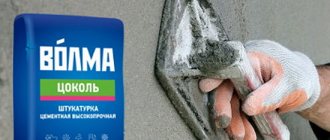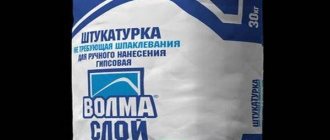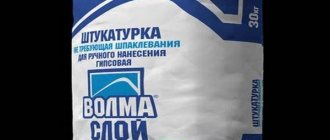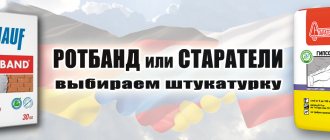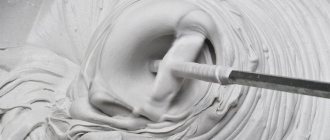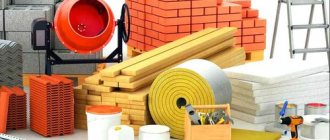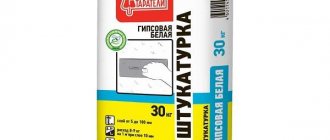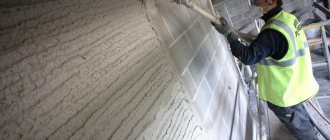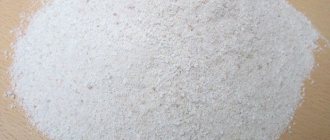07.04.2020
Looking for inexpensive and high-quality plaster mixtures for manual or machine application? Opt for products from the domestic manufacturer, the Starateli brand, and it will reward you with an unrivaled finishing result. Find out right now why Prospector plaster has won the hearts of professionals and amateurs alike since its appearance on the construction market.
In our previous article we wrote how to apply the Ceresite bark beetle plaster composition, now we will analyze the features of the Prospector material.
Description.
Prospectors, gypsum plaster, packed in 30 kg packs. The craft bag contains a dry concentrate with the addition of a special filler, which significantly reduces consumption.
The modifying components included in the composition provide excellent adhesion to the base, thereby reducing the time required to carry out work.
The mixture is used for plastering rooms with low humidity, built from brick, various concrete, foam-gas blocks and other solid bases.
The gypsum component is a high-quality product, it is not subject to cracking, retains thermal insulation properties, and has good sound insulation.
Gypsum plaster "Starateli" is used for repairing any residential and work facilities. The composition is not waterproof, so you should not plaster bathrooms or other rooms with high humidity. It is also not recommended to use the mixture in food industry buildings where there is direct contact with food and drinking water.
Basic information about the material
Plaster of the “Starateli” brand is produced by a well-known domestic manufacturer. Despite the fact that the company's product range includes plasters with cement and polymer binders, as well as decorative materials, gypsum mixture for interior work is considered the most popular.
Using plastic plaster for interior work
The limitation on the scope of application is due to the fact that gypsum does not tolerate moisture well, therefore mixtures without moisture-resistant additives cannot be applied to surfaces in the bathtub, shower, toilet, or other wet rooms. However, some Starateli gypsum plasters include special modifiers, so they are suitable even for cladding rooms with high humidity levels.
Plaster is widely used during construction and finishing work when arranging new buildings and private houses. It is equally well suited for restoration and repair of any residential, office or public premises. The building mixture is suitable for:
- sealing cracks and cracks;
- covering up chips;
- processing of ceilings, niches, arches, partitions;
- finishing walls before applying decorative plasters;
- surface treatment before gluing tiles.
Finishing walls with gypsum plaster
Plaster is ideal for walls made of brick, plasterboard, concrete and reinforced concrete, aerated concrete, cellular concrete, foam concrete. It fits perfectly on other gypsum and cement plasters. Due to its evenness, finely dispersed structure and versatility, the material can be used instead of putty. It is very easy to apply this building mixture, because it is plastic and pliable, so it is appreciated by both novice craftsmen and professionals.
Advantages.
- has economical consumption per sq. m;
- good elastic properties, easy to apply on hard substrates;
- creates an absolutely flat and durable plastered surface;
- after the base dries, an optimal temperature regime is created;
- the walls “breathe” after application;
- suitable for finishing, resulting in a perfectly smooth, even coating;
- Possibility of application manually or mechanically.
Apply the finishing concentrate in a single layer, up to 5 cm thick, locally up to 8 cm, at a time. The ceiling is plastered in one layer, which should be up to 2 cm thick and at least 1 cm thick.
Important! The next layer can be applied only after the previous one has completely dried.
To apply 1 mm of plaster per 1 square. m will require 0.9-1 kg of ready-made solution.
Necessarily! When diluted and applied to walls or ceilings, each subsequent layer should be lighter than the previous one. If the final one is much heavier, it may peel off or fly off completely.
In the building where finishing is carried out, the temperature should be optimal: not less than +5 degrees, but not more than +30.
“Prospectors” are used for leveling and preparing walls as a finish before decorating.
Gypsum plaster Prospectors: technical characteristics and seven benefits!
Despite the increased cost, gypsum mixtures have twice as many advantages compared to their cement counterparts, and in the end, a square of finishing will cost the same. This:
- Ecological cleanliness.
Gypsum mixtures are made from natural raw materials without toxic inclusions, therefore they are absolutely safe for the human body and can be used indoors. - No shrinkage.
During the hardening process, Starateli white plaster, the price of which is slightly higher than cement, does not develop cracks and allows you to create a perfectly flat and smooth surface. - A light weight.
Thanks to this quality, the load on load-bearing walls is reduced, which makes it possible to extend their service life several times. You can also use gypsum mortar to finish walls made of plasterboard, tongue-and-groove boards, gypsum boards and other lightweight materials. - Plastic.
During the application process you will not need a reinforcing mesh. The gypsum composition is quite viscous, so it does not flow down or deform even with multi-layer application. - Vapor permeability.
Gypsum plaster mixtures are not as dense as cement ones, so they do not interfere with natural air exchange and prevent the formation of fungus and mold on the walls and ceiling. - Excellent sound and heat insulation.
Walls covered with gypsum plaster are never icy. In addition, this coating reduces background noise. - High installation speed.
Just three days - and the gypsum solution will dry completely, which will allow finishing to be carried out without delays. While the cement composition will take 3-4 weeks to harden.
Note! To decorate a bathroom, basement or facade, choose moisture-resistant plaster Starateli. For interior work, use gypsum mixtures, which will reduce labor costs and material consumption by 2 times.
Preparing the base.
The walls and ceiling must be clean and prepared for work, that is, any old finishing (if any) must be removed and cleaned of any contaminants.
If the bases have the ability to absorb moisture, then priming is required. The primer must be applied strictly according to the instructions.
How to properly dilute the mixture.
- for one package of plaster, 16-20 liters of water are needed to prepare the working base;
- 1 kg of dry base will require about 0.7 liters of water;
- after dilution, the base should be allowed to settle a little, mix it well again, after which you can start working with it;
- You cannot add dry concentrate to the finished mixture or water;
- you cannot add other components;
- The finished solution must be used within 0.5-1 hour, because after that it will become unusable.
Calculation of plaster consumption rates
The next step is to calculate the consumption of gypsum plaster per estimated 1 m2. We choose a dry mixture from a certain manufacturer, in this case it will be Rotgypsum. On the packaging of the dry gypsum mixture it is noted that 1 m2 of wall will require 8.5 kg of dry material, if you adhere to the planned layer thickness of 10 mm.
Characteristics table
According to the calculations carried out to determine the average layer thickness, the required mass of dry plaster will be: 8.5x3 = 25.5 kg.
For finishing work, the consumption per 10 m2 of plaster will be: 25.5x10 = 255 kg.
Breeding methods.
Manual method.
The dry concentrate is poured into a plastic container, filled with clean water and mixed thoroughly. To obtain consistency consistency, you can use a construction mixer or an electric drill with a special attachment. The solution needs time to mature (about 5 minutes) and mix again. The resulting base is ready for use.
Mechanical method.
To dilute the solution, you will need a special pump (mortar mixer). Water and power are connected according to the instructions. The level of supplied water that enters the sediment is regulated. Dry concentrate can be loaded directly from a bag or from a silo or a hopper of a pneumatic transport system.
Application methods.
Manual method.
The prepared solution is applied to the walls with a trowel, spatula, etc. The walls are plastered using bottom-up movements. If it is necessary to apply two layers, then the first one should be “combed” with a coarse-toothed spatula for better adhesion.
On the ceiling, finishing is done with a spatula, moving towards you; plastering the ceiling, as mentioned above, is done in only one layer. Setting occurs after 2 hours.
Mechanical method.
Semi-mechanical application to the wall is carried out using a gun from the upper left corner, using movements from top to bottom. It is necessary to distribute the mixture in strips 70-80 cm long and 7 cm wide, each strip should overlap the other.
The finished base is applied to the ceiling from left to right, starting from the side opposite the window. The resulting thickness of the solution will depend on the speed of movement of the pneumatic bucket. Accordingly, the faster you move the gun, the smaller it will be.
To fully automate the process, special mechanical equipment is used, which allows work to be carried out in large volumes.
Material application technology
Exact instructions for working with the “Starateli” plaster are given on each package of the product. To obtain a high quality coating, these instructions must be strictly followed.
Surface preparation
First you need to carefully prepare the base. To do this, remove old, peeling plaster, wipe off dirt, dust, and sand off deposits of construction mixtures. Oil stains are washed off with solvents. Metal elements (for example, fasteners) are coated with special anti-corrosion solutions to prevent them from rusting in the future. Otherwise, rust stains will appear through the plaster layer.
To improve the quality of adhesion of the plaster to the base and remove dust, apply 1-2 layers of primer and allow it to dry well. If the surface does not absorb moisture well, use the Betonokontakt primer. For highly absorbent substrates, “Starateli Universal” primer is better suited. After the composition has dried, they immediately begin the main stage of work.
Surface priming
Preparation of working solution
To dilute the plaster, prepare a large, convenient plastic container, clean water, as well as a drill with a mixer attachment or a special construction mixer. Determine a portion of plaster that can be used in half an hour, and prepare exactly this volume of product. The excess will most likely begin to harden and be irrevocably damaged.
Water is poured into the container, measured strictly according to the manufacturer’s recommendations. Pour plaster into the liquid in parts, beat the mass with a mixer until even the smallest lumps disappear from it. After a couple of minutes, knead the composition again, after which it will be ready for use. No additional components other than those present are added. An exception is dry pigment or dye diluted with water for a decorative composition (the liquid must be included in the general norm for diluting plaster).
Mixing plaster mortar
Plastering surfaces
If you plan to apply a thick layer of plaster, the surface is reinforced with a special fiberglass mesh. Reinforcement of ceilings is carried out when the layer thickness is over 2 cm.
Manual application
To apply the solution, use a trowel, a wide spatula and a rule. On vertical bases, apply the product in heaps on the wall, then move the tool from bottom to top. If the surface has a horizontal direction, as well as when working with the ceiling, move the trowel or spatula towards you, then go over the plaster layer as a rule. If you plan to apply the plaster in several layers, the first one can be pulled out with a notched trowel to enhance adhesion to the wall. Then the surface is leveled in any case according to the rule.
40 minutes after leveling the plaster, the protruding beads and “islands” are cut off using the same rule. The holes are filled with fresh mortar and smoothed with a spatula. To prepare the base for wallpaper or painting, a fine finishing is carried out: moisten a construction float with water and rub the surface well. With high-quality rubbing, the base will not need to be puttied, but only primed.
Mechanical application
To apply mortar using a mechanized method, you need to have a special gun available. Its container is filled with plaster, after which the product is sprayed in strips 7 cm wide and up to 70 cm long. Each subsequent strip is applied slightly overlapping the previous one. Usually, with the mechanized method, walls are plastered in only one layer.
The ceiling can also be treated using a plaster gun. Finishing begins on the side of the wall that is furthest from the window. The higher the speed of the gun, the thinner the plaster layer will be. You should not decorate the ceiling with plaster more than 2 cm, otherwise the material may peel off. After distributing the building mixture using a gun, it is leveled with a rule and a grater.
Applying plaster using mechanized machines
If a mechanized method is used, safety precautions must be observed. Personal protective equipment (gloves, overalls, goggles, respirator) will prevent damage to the eyes, skin, and respiratory organs during work. Their use cannot be ignored!
Product cost.
The cost of gypsum plaster “Prospectors” is 30 kg, on average 280-310 rubles. The final price will depend on the volume of the mixture purchased and the pricing policy of the supplier.
In order to calculate the required amount of dry concentrate in bags, you should use the formula: 10 (per 1 sq. m. thickness 10 mm.) * number of squares * coating thickness / 30 kg. This gives the number of bags of mixture.
This formula allows you to calculate the required number of bags only approximately. It is simply impossible to calculate the exact amount.
Main technical characteristics of gypsum prospector plaster:
- the color of the dry powder can be gray or white;
- the optimal application layer is 5-8 cm;
- designed for interior finishing work;
- the resulting solution retains its working properties for about 50 minutes;
- the temperature of the surface of the walls and ceiling should not be lower than +5 degrees;
- the mixture is sold in 30 kg bags.
The main advantages of Prospector plaster
Since 1992, the products of the domestic manufacturer have been pleasing consumers with high quality and compliance with proportions in each package. In addition, the price of Starateli plaster will not be a burden on the budget. Its cost is up to 25% lower than its advertised European counterparts.
- wide selection of formulations
- high elasticity;
- 100% environmentally friendly;
- uniform application;
- different setting times for compositions;
- possibility of manual and mechanized application;
- high speed of finishing work;
- no shrinkage;
- crack and frost resistance;
- reducing the load on the foundation;
- minimum consumption.
Prospectors with the Bark Beetle effect.
Decorative plaster “Bark beetle” from Starateli, available in 25 kg bags. The basis of the mixture: white cement, dolomite chips, with the addition of modified polymer compounds.
It is used to decorate interior and exterior walls. It is applied to smooth, hard, cement substrates. After application, a thin coating with a grooved texture is formed for subsequent painting.
Prospectors "Optimum".
Optimum Prospector plaster combines gypsum and cement components and is also available in Kraft bags.
It is used on surfaces with normal and high humidity, both inside and outside. The color scheme is light gray. It is possible to cover walls with Optimum Prospectors plaster up to a maximum of 9 cm. But the recommended thickness is still 6 cm. For 1 bag of dry component, 11-14 liters of water will be needed to dilute the solution.
The consumption of “Optimum” Prospector plaster per m2 with a centimeter coating is 11 kg.
KNAUF
- Full photo
A universal plaster mixture based on gypsum binder with polymer additives, for interior decoration of residential premises, hotels, hospitals and other premises with normal air humidity (including kitchens and bathrooms). Very convenient to use.
Consumption rate
The consumption of Knauf HP-Start dry mixture is about 10 kg/m² with an applied layer thickness of 10 mm. From 30 kg (bag) of dry mixture, about 30 liters of ready-made solution is obtained.
Recommendations
To ensure quick drying of the plaster, it is necessary to ensure good ventilation of the room. Before applying the decorative coating, the plaster must be treated with Knauf Tiefengrund primer. Wash equipment and tools with water immediately after work. Contaminated containers and tools reduce the time of use of the plaster solution.
Packing and storage
Knauf HP-Start mixture is packaged in 30 kg paper bags. Store in dry rooms on wooden pallets. Use material from damaged bags first. Shelf life in undamaged packaging – 6 months
- Operation 1
- Operation 2
- Operation 3
- Operation 4
- Operation 5
- Operation 6
- Operation 7
Surface preparation
The foundation must be strong, stable, without visible damage, and not frozen. The surface of the base must be dry, strong, free from dust, dirt, and loose elements; if necessary, remove form lubricant from concrete surfaces. The temperature of the base for plaster and the room should not be lower than +5°C.
Surfaces with normal and highly absorbent properties (lime and cement plaster, gypsum board...) are treated with Knauf Tiefengrund primer.
Hygroscopic (highly absorbent moisture) substrates, for example, silicate and ceramic bricks, cauldrons, should be treated with Knauf Grundiermittel primer diluted in a ratio of 1:3 (surfaces made of aerated blocks, to prevent uneven setting of the plaster mortar, it is recommended to treat them 2 times with a dilution of 1:4) .
Cement-sand composition.
Cement-sand plaster “Starateli” is produced for external repair work and plastering of the base (coating thickness no more than 3 cm).
Cement-sand plaster “Starateli” can be used to cover already plastered surfaces; this is convenient when it is necessary to mask defects: deep depressions and chips.
You can purchase cement-sand plaster “Starateli” in 30 kg bags. Consumption: per 1 sq. m with a layer of 1 cm will be 12 kg. Finishing can be carried out at any humidity and temperature (in this case there are no fundamental requirements).
Table: Comparative consumption of Prospector plaster per 1m2
| Brand | Estimated layer thickness, mm | Consumption, kg/m2 | Packaging, kg |
| Mixter | 10 | 10 — 11 | 30 |
| Plaster | 10 | 8 — 9 | 15 / 30 |
| Optimum | 10 | 10 — 11 | 30 |
| Plaster white | 10 | 8 — 9 | 30 |
| Cement-sand Universal | 10 | 11 — 12 | 30 |
| Gypsum machine application | 10 | 8 — 9 | 30 |
| Cement-sand | 10 | 12,5 — 13,5 | 25 |
| Plaster spray | 5 | 5 — 6 | 25 |
| Bark beetle | 1,5 — 2 | 2 — 2,5 | 25 |
| Bark beetle 3mm | 3 | 3,5 — 4 | 25 |
| Fur coat | 3 | 4 — 4,5 | 25 |
Still have questions? CALL!
Facade mixture.
Facade plaster "Starateli" is used for external work on building facades. It contains: cement, sand, lime and additional additives.
The optimal thickness for applying façade plaster “Starateli” is 1-2 cm. The resulting ready-made solution retains its properties for 2 hours.
The surface to be plastered must not be frozen; the base must have a temperature of more than +10 degrees.
Composition and color palette
The basic binding component of plaster is white or gray gypsum - a lightweight but durable mineral material. To optimize the properties, the mixture includes other minerals, fillers, modifiers, plasticizers, and additives.
On sale you can find “Prospectors” plaster of gray or white color; sometimes a pink construction mixture is sold, and this shade appears not due to the introduction of pigment, but due to the special color of natural gypsum. If necessary, the material can be tinted after dilution or the powder can be mixed with dry pigment.

